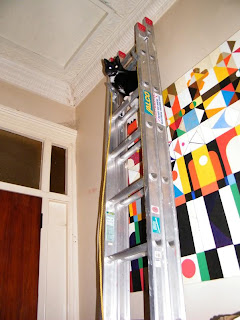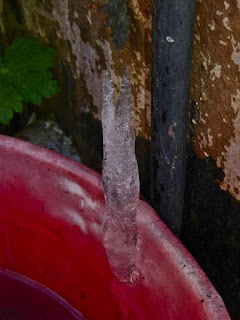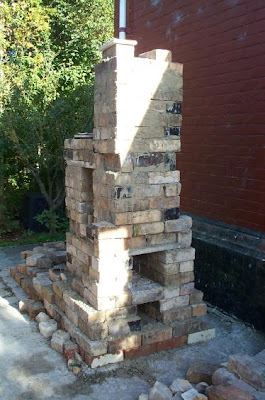Going Crazy
Nigella Stopit has been climbing ladders.
Ginger (The Right Honourable Mr Goongley Esquire)
has been making an exhausting study of glaze chemistry.
The kiln has been fired at least 7 times over the last few weeks to a range of temperatures from cone 03 to cone 4 mostly full of glaze tests. The photo shows most of that range of temperatures (cone 01 is missing although I did fire that as well). Orton cone 03 is just shy of 1100 degrees C (2012F). Cone 4 is about 1175 C in my kiln (2147F), but the actual temperatures that the cones bend at also depends on the time taken to get there, so they are really a measure of heat work.
 |
| Notice the change from a sandy red in the area that is glazed at cone 3 to a brown at cone 4. |
It is rumoured that the crazy potter of Waikouaiti Old Post Office has been trying to make a lead free clear glaze that will fit the earthenware clay from his part of the world.
Prior to the most recent batch of 18 bowls being made on the wheel, about 40 bowls were made.... glazed, and mostly.... discarded. It would seem that test tiles, though helpful, are no substitute for testing on real objects.
 |
| All these were supposed to be "clear" glazes... yes, well! |
July was one of the most frustrating and infuriating months imaginable in the studio, and it all was triggered by saying "yes" to a simple commission to make 12 earthenware bowls glazed on the inside with a clear lead free glaze, from there things just seemed to pick up a momentum all of their own... like a small pebble triggering a landslide!
Anyway, that is a brief summary of a horrid month in which quite a lot was learned and very little earned.
The big problem has been one of glaze fit. Firing several loads of tests at increasing temperatures did give useful information about the clay, for instance.., it can go to cone 3 before it begins to change from red to brown, and it is still bloat free at cone 4, this is quite a high temperature for an earthenware clay. To get a glaze to fit this clay without crazing, the glaze needs to be very low expansion. I did make considerable progress with my testing, and the many glaze test tiles gave me a few glazes that could cope with several cycles of being plunged into boiling water for 5 minutes, then into really cold water for 5 minutes, and then back to boiling... and so on. Well, the glazes worked on the test tiles. It was another matter when applied to bowls. Imagine the sight of a kiln load of small bowls that start crazing as soon as they are unloaded after being fired... Not good after 3 weeks of testing glazes on tiles. And, yes it was daft to glaze a lot of bowls with a glaze that had only been tested on tiles......... but pressure, tiredness, and deadlines do lead to silly decisions sometimes.
Re-firing the crazed bowls and doing a really long soak from cone 03 to cone 3 has given me bowls that, so far, haven't crazed after nearly a week, but they cannot get through the boiling chilling test.
Sadly, the many setbacks with all this has made me way behind with many other jobs that I should be doing. I have also forgotten how to sleep, and that has become a major problem. I have attempted several blog posts, but have never managed to finish them. I will post this one, but it will be rather unpolished and raw.
 |
| When all else fails, oven testing unglazed bowls is fun, and the bread is yummy! |
One definite ray of sunshine has been downloading a trial copy of Insight glaze calculation software from digitalfire.com, I am only just starting to learn how to use this, but I want to say how delighted I am that it is offered in versions for Windows, Mac, and Linux. As a Linux user I am really pleased not to be "left out". The day after I downloaded a copy, I found an email from Tony Hanson of digitalfire.com which began as follows
"I see you downloaded a copy of our INSIGHT software.
Were you able to install it OK? Did it make sense?Would you like to correspond to understand it better and see how it can help you?"..... "What sort of glaze issues are you having right now? Can I suggest how you might use our software to solve these?"
Yes, I realise that this was good marketing, and was probably an automatic response, and I nearly didn't reply. But I did, and, after thanking Tony for the Linux version, I outlined the glazing problem I am having. I was delighted to receive a long and thoughtful reply, and also further help and support after I responded to that. This help is way beyond what could be expected, especially when you consider I have so far only downloaded the free demo of the software. Tony is the prime developer of the Software too, and must be a busy person, so it is hugely appreciated.
I have found the digitalfire.com site a very useful one for many months now as there is a large library of articles that concern glaze testing and formulation and other useful things, and the information is there for anyone to make use of. I found it very useful when I was struggling my way through cone 6 glazes last December. You can find that at http://digitalfire.com/4sight/education/index.html.
Isn't it great when people share information!
Anyway, I'll press the Publish button about now. My next job of the day is to pack some things into the kiln for a bisque firing.






Comments
I had a call today, could you do X that you have never done before in your life and have it ready my the first of October.
I said, No.
No,no,no,and no.
Good luck and I hope something wonderful comes from this.
Now get some rest.
Wise words! It is just starting to occur to me that I should remember to say No sometimes... but I am a slow learner!
Good to hear from you. One cat sleeping in an early morning haze of contentment in front of the electric heater as I write this..., how do they manage it whilst the rest of us run around trying desperately to earn enough to pay for their cat food!?! I think that they are further up the evolutionary ladder than me. Probably cats would share a similar rung on the ladder to the seals that live around the coast here. They do nothing other than lie around in the sun all day scratching and sleeping, with an occasional break from that to do a relaxed spot of fishing! Wonderful!
Thank you for your kind comment, welcome to my blog. I am amazed at how all the written and pictorial material accumulates over time, and it is good to have that record... I'm glad that you are enjoying working through it. It is nice that you and your husband are able to work together on the pottery, so much more can be achieved when skills are shared, and it is more fun too. I wish I had purchased the Digital Fire software ages ago, it is very useful, and I am already understanding glazes much better than I did previously.
Do you have a web site or blog, it would be lovely to see your work?
Best Wishes to you and Jim, P